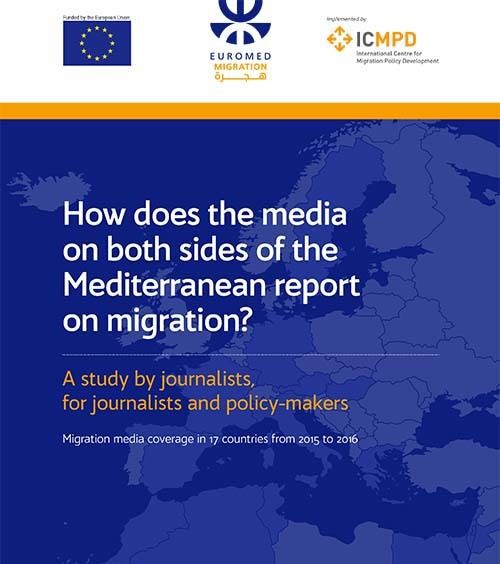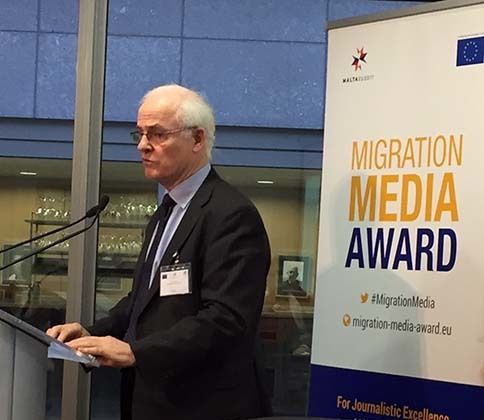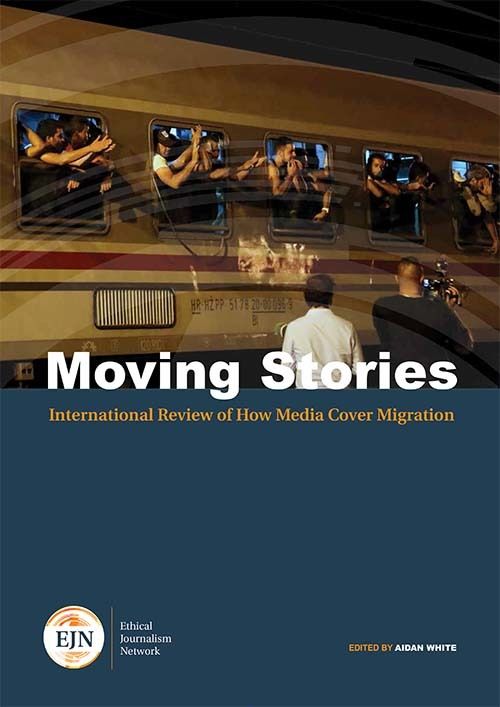Can media cover migration effectively and are adequate resources provided for such a gargantuan endeavor, notably in Mediterranean countries facing an unprecedented influx of people seeking shelter from conflicts and better economic opportunities?
“How does the media on both sides of the Mediterranean report on migration? A study by journalists, for journalists and policymakers: Migration media coverage in 17 countries from 2015 to 2016” is a joint effort of the Ethical Journalism Network, the European Union, Euromed Migration and the International Center for Migration Policy Development.

Screen shot of media migration report
It was presented at a pre-launch event at the Brussels Press Club during which organizers announced the creation of the Migration Media Award.
This is a summary of the Lebanon chapter I wrote “Mixed Messages as Media Cope with Internal Stress and External Pressure.”
With Lebanese media mired in dysfunctional domestic politics, facing regional security threats and international upheavals, and troubled by their own shaky existence, it’s no surprise there’s been a hodgepodge of migration coverage since 2015.
Although glossaries of migrant-related terminology - provided by international organizations and NGOs – exist, journalists covering the story still use terms like “migrant,” “refugee” and “settler” incorrectly and interchangeably.
Glossaries are not always updated fast enough to keep up with the media’s needs, and not necessarily available in the three main languages used in Lebanese news outlets: Arabic, French and English.
Statistics are a tricky topic. The government’s figures on the number of Syrian refugees and migrants may vary from those of international organizations and United Nations agencies tasked with registering asylum seekers.
A sticking point is the number of undocumented residents who slip undetected across borders, evade aid agency safety nets, and disappear through the cracks of bureaucracy.

Screen shot of Middle East map with Lebanon in the eastern Mediterranean
Lebanon is not a signatory to the 1951 UN convention on “non-refoulement,” or not sending refugees away once they arrive.
Sociologist Mona Fayad, in an analysis in Annahar daily on media’s role in dealing with Syrian migration, said Syrian refugees, exceeding a third of the population, threatened Lebanon’s social equilibrium and that the impact had begun to manifest itself in the rising rate of violence and security incidents involving Syrians who accept aid in exchange for services rendered to partisan groups.
Her article also touched on the causes of youth radicalization in migrant and refugee groups and neighboring disadvantaged local communities, and the friction caused by their interaction.
“We shouldn’t overlook the fact that the Syrian migration comes against a backdrop of Lebanon undergoing a dangerous political, economic, and social crisis tied to domestic problems and the conflict in Syria,” she said, noting that all these factors could undermine security and become a time bomb in the medium and long term.
Lebanon, whose population is about four million, hosts upwards of 1.5 million Syrian refugees, and some half a million Palestinians in camps established after the creation of the state of Israel in 1948, to which were added thousands of Iraqis fleeing the violence in their country after the US invasion in 2003.
Naharnet, quoting the United Nations, reports that more than half the Syrian refugees in Lebanon do not have valid residence permits, leading to a rising number of unregistered newborns.
Additionally, many Syrian refugees are hamstrung by measures making it almost impossible for them to obtain or renew their residence permits. As a result children are dropping out of school – if they even attend – and replacing adult men to become their families’ main breadwinners.
Lebanon has a turbulent history, including a civil war from 1975 to 1990 during which print and broadcast media were created to service warring factions, mostly along sectarian and politically ideological lines. They competed with state-run outlets and have morphed into commercial, albeit partisan, ventures.
Radio stations and TV channels continue presenting their founders’ views, if not in full militia fashion as during the war, but their bias is inescapable.
While examples of fair and balanced coverage of migrant-related issues exist, they seem to have been overshadowed by a proliferation of hate-mongering journalism. Those listed in this report focus on the negative coverage and its ramifications.
Shifting political alliances since the Syrian conflict began in 2011 have also meant a certain degree of recurrent escalation or de-escalation in the tone used by some media outlets.

Ethical Journalism Network director Aidan White (Abu-Fadil)
There was no reporting in these examples on the diaspora in general, remittances, diaspora investments, and little on migrants’ repatriation, save for Lebanese politicians’ statements about setting up safe havens within Syria for those escaping the violence.
Most of the emphasis was on the politics, economics, development/aid and security angles of the story. As with donor fatigue, there is refugee fatigue, so stories involving Syrians reflect the mood.
Emotional, human interest and fact-based issues dominate the news agenda when security and terrorism matters are at stake or when crimes are committed; when Lebanon receives or requests more foreign assistance to handle the flood of Syrians; and when international dignitaries and celebrities visit refugee camps.
Major challenges in telling the migration story from inside the newsroom include:
• Access to reliable data and statistics. Data come from conflicting sources with an interest at stake, so verification can be problematic;
• Political and economic interests that influence media coverage and combine with sectarian, religious, and social considerations;
• The presence of hate speech in public discourse, which has become increasingly common. Politicians take to different media platforms to blame their rivals for policy mistakes and social media used by all sides add fuel to the fire by repeating offenses that lead to hate crimes;
• The lack of voices for migrants; some media fail to be inclusive because of other priorities, interests, budgets and deadlines.
In all of this, social media play an increasingly visible and influential role in coverage of migrants.
In some cases it’s positive, like rallying support for needy refugees, but it can also be negative, blaming them for rising crime figures, or for adding to demand for basic services and putting pressure on crumbling infrastructure. This often inflames politicians’ negative statements.
A tendency to sensationalize and to use stereotypes has always been present in Lebanese media but this ebbs and flows with the magnitude of crises.
In television, it’s common for newscasts to begin with the headlines followed by an editorial-cum-opinion introduction passing off as news.
That segment is used to lash out at adversaries, criticize policies and practices, defend positions, and draw attention to certain causes, before delving into actual news reports.
Online media provide a wider spectrum, given the possibility of posting content 24/7 but social media and comments – where available – are fertile ground for exacerbating matters.
Editorial bias is inevitable in a country where media answer to political, economic, religious and sectarian patrons and where neighboring Syria, whose government is both villain and hero to different groups of Lebanese citizens, is an inextricable part of Lebanon’s history.
During the Lebanese civil war Damascus sent troops under Arab League auspices to help quell the violence. This led to 30 years of heavy-handed tutelage.
The troops were chased out following a civil revolt in 2005 after former prime minister Rafic Hariri was assassinated, but Syrian influence over internal Lebanese affairs remains strong.
Meanwhile, the levels of competence and skills of journalists covering the migration story range from good to mediocre.
In general, underpaid journalists don’t have fixed beats so reporters may cover different topics on a given day leaving little time to worry about the political correctness of choosing the right terms.
Moreover, drastic budget cuts in most media mean journalists have to multitask on fieldwork and may also spend more time covering from their desks to meet increasingly shorter deadlines.
Pressure of time and limited sources of information hinder Lebanese journalists.
Advertising revenue has been falling for many years and newspapers have laid off editorial staff, or cut the number of pages, and turned their attention to digital publishing. An enormous burden falls upon the remaining journalists.
Where there’s engagement with the audience it varies from cursory to non-existent. Staffers may respond to comments and social media posts, but more often individual journalists active on social media do the engaging.
This chapter provides 11 case studies of media controversies in 2016 arising from migration-related coverage.

Moving Stories Cover (courtesy EJN)
“Moving Stories,” an earlier report by EJN, on how media cover migration worldwide, is available here.
